INTRODUCTION
Health is wealth—a simple yet profound truth. One sickness can drain a
lifetime of savings, leaving individuals and families in distress. While modern
medicine has made remarkable strides in diagnosing and treating diseases, many
health conditions continue to defy medical solutions, pushing us to explore
alternative approaches.
Natural remedies have been a cornerstone of healing for centuries, long before
the advent of modern pharmaceuticals. Across cultures and civilizations, people
have relied on nature’s gifts—herbs, roots, fruits, and holistic practices—to
restore health and vitality. While this encyclopedia does not seek to undermine
the importance of medical science, it aims to complement it by shedding light
on time-tested natural solutions.
NATURAL REMEDIES FOR DIVERTICULITIS
Diverticulitis is a condition where small, bulging pouches (diverticula)
in the wall of the colon become inflamed or infected. These pouches
develop due to weakness in the colon walls, often as a result of
increased pressure. Diverticulitis can cause symptoms like abdominal
pain (typically on the lower left side), fever, nausea, and changes in
bowel movements. It often occurs as a complication of diverticulosis,
a condition where the diverticula are present but not inflamed.
Treatment generally includes antibiotics for infection, and in severe
cases, surgery may be necessary. Managing diverticulitis involves
addressing the acute phase and preventing future flare-ups by making
dietary changes and adopting a high-fiber diet.
1. Clear Liquid Diet during a Flare-Up
How it works: During an acute flare-up of diverticulitis, the
digestive tract needs time to rest. A clear liquid diet can provide
hydration and essential nutrients while reducing the strain on the
colon.
Preparation: Consume clear liquids such as broths, clear soups,
herbal teas, and water. Avoid dairy products, juices with pulp, and
high-fiber foods during this phase.
Usage: Stick to the clear liquid diet until symptoms improve and
you feel ready to transition to solid foods. Always follow the
guidance of a healthcare provider.
Where to find: Clear broths and herbal teas are readily available
in most local markets.
2. Gradual Introduction of High-Fiber Foods
How it works: After the acute phase, a high-fiber diet can help
prevent future flare-ups by easing bowel movements and
reducing pressure on the colon. Fiber helps promote regularity
and can prevent constipation, which is a common contributor to
diverticulitis.
Preparation: Gradually incorporate high-fiber foods such as
whole grains, vegetables, legumes, and fruits into your diet. Start
slowly to allow the digestive system to adjust.
Usage: Introduce fiber-rich foods slowly, beginning with easily
digestible options like cooked vegetables and oats, and gradually
increasing fiber content over time.
Where to find: High-fiber foods such as whole grains (brown
rice, quinoa), vegetables (broccoli, carrots), and fruits (apples,
pears) are commonly available in local markets.
Key Consideration
It’s essential to consult a healthcare professional before beginning any
treatment for diverticulitis. A clear liquid diet should only be followed
during the acute phase, and a high-fiber diet should be reintroduced
gradually under medical supervision. If symptoms worsen or do not
improve, it is crucial to seek medical attention immediately.



